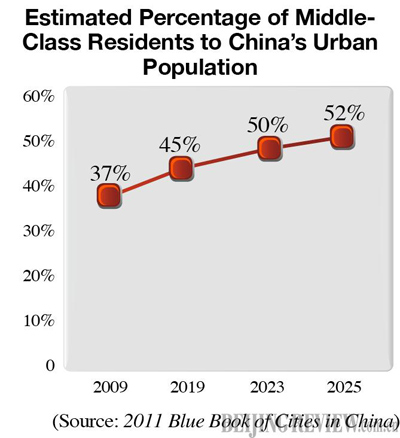|
Chinese researchers usually use income, profession and education as most essential criteria in determining middle-class status, and some scholars also use consumption level in their studies.
In 2005, the National Bureau of Statistics released a survey, which showed the urban middle class should have an annual income between 60,000 yuan ($9,405) and 500,000 yuan ($78,376). At the time the bureau estimated that the middle class constituted 5 percent of urban Chinese residents.
In her newly published report, Zhang classified households with an Engel's Coefficient of between 0.3 and 0.373 as middle class. The Engel's Coefficient refers to the share of food in total household expenditure.
Zhang chose to use consumption level rather than income as a measure of middle-class status, because, she said, Chinese citizens are often hesitant to disclose their full incomes, and there are huge disparities in living costs between China's regions.
According to the UN Food and Agriculture Organization, the Engel's Coefficient for the richest segment of society is typically below 0.3 and for the wealthy stands at between 0.3 and 0.4. Zhang said she chose the 0.3 to 0.373 range for China's middle class after taking into account Chinese citizens' consumption and living patterns and China's socio-economic system.
But Zhang's conclusion that China had 230 million middle-class urban residents in 2009 has been widely criticized. A netizen known as Wuyue Sanren said the Ministry of Finance's (MOF) statistics show only 24 million people in China make more than 3,500 yuan ($549) per month, the personal income tax exemption threshold effective on September 1. "How can a person with income below the income tax exemption threshold level qualify as a middle class?" Wuyue Sanren said.
Zhang said the MOF's data were based on individuals' reported incomes, while hers were based on household spending. Since many Chinese people have off-book income, Zhang said she believed household spending provides a more accurate picture of people's lifestyles.
Wang Jian, Secretary General of the Chinese Society of Macroeconomics of the National Development and Reform Commission, said he thought Zhang's estimate was more or less accurate.
Wang admitted China's present high inflation had placed an enormous strain on all citizens, but he said even struggling mortgage payers remained middle class in comparison to people who cannot even afford a down payment.
Painstaking growth
"Currently, the shape of China's income structure is not an olive with a bulging middle and tapering ends, but a pyramid with a large group of low-income people at the bottom," said Li at Beijing Normal University.
But Zhou Tianyong, a professor at the Party School of the Central Committee of the Communist Party of China, tends to believe China's income structure takes an inverted T shape, with the middle to high-income population constituting the vertical bar and the bulk of the people being the horizontal bar at the bottom.
Zhou said the best way to produce an olive-shaped income structure in China is to boost the growth of small and medium-sized enterprises.
"In China, the number of owners and managers of small and medium-sized enterprises is relatively small, as the growth of small and medium-sized enterprises is inhibited by heavy taxes and difficulties in fundraising," Zhou said.
Using data released by the State Administration for Industry and Commerce, Zhou calculated China had 12 enterprises per thousand people, whereas China's Taiwan and South Korea each had 50 enterprises per thousand people.
"If China has 50 enterprises per thousand people and each company is run by at least two people, then one 10th of the country's population will be middle class," he said.
China's growing income disparity between a high-income elite and the struggling remainder of the population remains an impediment to changing the structure of the country's income pyramid.
"With the growing income gap, it is difficult to have a fast-growing middle class, said Chi Fulin, a researcher with the China Institute for Development and Research, a think-tank based in south China's Hainan Province.
Chi believes a rapid expansion of the middle class will only happen if China increases wages in its service and hi-tech sectors. "It is difficult for an economy dominated by investment and industry rather than services to breed a mass middle class," he said.
According to Bai Chongen, a professor at the Tsinghua University's School of Economics and Management, the share of household income in total national income dropped from 63 percent in 1993 to 52 percent in 2007, whereas in the same period, the share of government revenues increased 9 percentage points, and that of enterprises' income went up 2 percentage points.
He called on the government to increase expenditure on public programs and distribute dividends of state-owned enterprises to citizens, saying these efforts will greatly reduce the burden on citizens.
The urban-rural income gap and income disparity across regions and industries also remain a source for concern. In order to encourage emergence of a genuine middle class in China, Bai also suggested the government reform the transfer payment system for underdeveloped regions, push forward urbanization and tackle monopolies.

| 